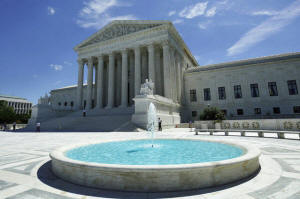|
Fight over electoral district boundaries
heads to Supreme Court
 Send a link to a friend
Send a link to a friend
 [September 18, 2017]
By Andrew Chung [September 18, 2017]
By Andrew Chung
WASHINGTON (Reuters) - It is a political
practice nearly as old as the United States - manipulating the
boundaries of legislative districts to help one party tighten its grip
on power in a move called partisan gerrymandering - and one the Supreme
Court has never curbed.
That could soon change, with the nine justices making the legal fight
over Republican-drawn electoral maps in Wisconsin one of the first cases
they hear during their 2017-2018 term that begins next month. Their
ruling in the case could influence American politics for decades.
Wisconsin officials point to the difficulty of having courts craft a
workable standard for when partisan gerrymandering violates
constitutional protections. Opponents of the practice said limits are
urgently needed, noting that sophisticated technological tools now
enable a dominant party to devise with new precision state electoral
maps that marginalize large swathes of voters in legislative elections.
"There is a sense that something has gone amiss with American democracy,
that there is this effort to rig the rules of the game," said Michael
Li, an expert in redistricting at New York University School of Law's
Brennan Center for Justice. "Gerrymandering used to be a dark art, and
now it's a dark science."

The justices will hear arguments on Oct. 3 in Wisconsin's appeal of a
lower court ruling that found that the electoral map drawn by state
Republicans ran afoul of the U.S. Constitution.
The map, drawn after the 2010 U.S. census, enabled them to win a sizable
majority of Wisconsin legislative seats despite losing the popular vote
statewide to the Democrats. The party's majority has widened since.
The justices must decide whether courts should have a say in such
matters. The Supreme Court for decades has been willing to invalidate
state electoral maps on the grounds of racial discrimination but never
those drawn simply to give one party an advantage.
The justices have never settled on a standard by which partisan
gerrymandering claims can be measured. In a 2004 case, Justice Anthony
Kennedy left the door open for a "workable standard" to eventually be
found.
Kennedy, a conservative who sometimes sides with the liberal justices on
a court with a 5-4 conservative majority, could cast the deciding vote
in the Wisconsin case.
A federal three-judge panel ruled 2-1 last November that Wisconsin's
redistricting plan violated the U.S. Constitution's 14th Amendment
guarantee of equal protection under the law and First Amendment right to
freedom of expression and association.
Over the decades, both Republicans and Democrats have been accused of
gerrymandering. Since 2010, Republicans' control of redistricting has
coincided with major seat advantages for them in state legislatures, the
Brennan Center said.

It is not just Republicans who are accused of abuses. Republican voters
sued over districts drawn by Democratic lawmakers in Maryland and have
appealed to the Supreme Court.
State and federal legislative district boundaries are reconfigured after
the U.S. government conducts a census every decade so that each one
contains about same number of people, typically by the party that
controls the state legislature.
[to top of second column] |

The U.S. Supreme Court building is pictured in Washington, DC, U.S.
on June 26, 2017. REUTERS/Yuri Gripas/File Photo

The Republican National Committee and several conservative groups
have backed Wisconsin, but leading Republicans including Senator
John McCain, 1996 presidential nominee Bob Dole and Ohio Governor
John Kasich have joined critics who argue that partisan
gerrymandering distorts the democratic process.
'SOCIAL-SCIENCE HODGEPODGE'
Wisconsin Republicans argued that election results since their
redistricting plan was passed in 2011 reflect the state's political
geography, with Democrats concentrated in cities like Milwaukee and
Madison and Republicans more spread out around the state.
The state also took issue with metrics that the lower court used to
determine that there was a significant partisan bias in the
redistricting plan. This "social-science hodgepodge," the state told
the justices, makes it impossible for judges to fairly determine
when an electoral map is unlawful.
"Plaintiffs' social-science approach would sow chaos. Each
legislatively drawn plan would be immediately challenged in federal
court," the state said in a legal brief to the justices.
Nicholas Goedert, a Virginia Tech redistricting expert who testified
in court for Wisconsin, said the metrics may be inappropriate
because their results can change from one election to the next.
Goedert noted that large shifts in the mood of voters can cause even
highly biased electoral maps to flip.
"Partisan maps have a tendency to backfire on the party that drew
them," Goedert said.

The case began in 2015 when a dozen Wisconsin Democratic Party
voters sued state election officials claiming the redistricting law
intended to discriminate against them for their political beliefs
and create enduring Republican majorities.
They urged the justices to either greenlight the lower court's
method of deciding cases of partisan gerrymandering, or create their
own.
"Government should treat voters equally regardless of their
viewpoint and we have ways to measure it," said Danielle Lang, an
attorney for the plaintiffs.
If the justices rule that courts must stay out of this highly
political process, voters will lose, Lang said.
"There would be no way for voters to rein in partisan
gerrymandering, no way for voters to take back control of their
government."
(For a graphic on Wisconsin state electoral maps, click
http://tmsnrt.rs/2haOPD5)
(Reporting by Andrew Chung; Editing by Will Dunham)
[© 2017 Thomson Reuters. All rights
reserved.]
Copyright 2017 Reuters. All rights reserved. This material may not be published,
broadcast, rewritten or redistributed. |